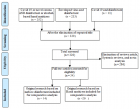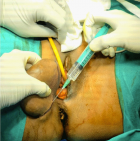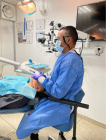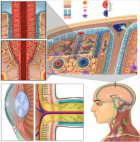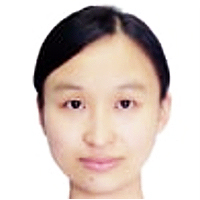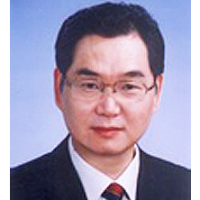Abstract
Case Report
The Clinical Pregnancy and Live Birth Following Transfer of One Arrested Embryo: A Case Report
Ali Asghar Ghafarizade, Elham Shojafar*, Samira Naderi, Fatemeh Seifi, Alireza Noshad, Zohreh Lavasani, Zahra Kalhori and Elahe Ghadiri
Published: 22 October, 2024 | Volume 7 - Issue 4 | Pages: 112-114
Background: One of the problems in vitro fertilization (IVF) treatment for infertility is the high frequency of embryo developmental arrest in the preimplantation stages. Arrested embryos were not selected for transfer and were usually discarded.
Case report: We present a case of clinical pregnancy and live birth following IVF treatment and transfer of one arrested embryo. A 31-year-old woman with unexplained infertility underwent IVF treatment. Using the IVF procedure, 7 embryos were produced which were frozen on day 3. In order to embryo transfer in the blastocyst stage, two embryos were thawed and cultured for 2 days. After thawing, one of them was not suitable for transfer and another embryo was arrested at the 10-12 cell stage.
Discussion: The Clinical pregnancy and live birth happened after the transfer of an arrested embryo on day 5.
Conclusion: This case showed that arrested embryos may resume growth after the transfer to the uterus and result in a successful pregnancy and live birth.
Read Full Article HTML DOI: 10.29328/journal.cjog.1001175 Cite this Article Read Full Article PDF
Keywords:
ICSI; Embryo transfer; Pregnancy; Live birth
References
- Sfakianoudis K, Maziotis E, Karantzali E, Kokkini G, Grigoriadis S, Pantou A, et al. Molecular drivers of developmental arrest in the human preimplantation embryo: a systematic review and critical analysis leading to mapping future research. Int J Mol Sci. 2021;22(15):8353. Available from: https://doi.org/10.3390/ijms22158353.
- Xu KP, Yadav BR, Rorie RW, Plante L, Betteridge KJ, King WA. Development and viability of bovine embryos derived from oocytes matured and fertilized in vitro and co-cultured with bovine oviducal epithelial cells. J Reprod Fertil. 1992;94(1):33-43. Available from: https://doi.org/10.1530/jrf.0.0940033.
- McCollin A, Swann RL, Summers MC, Handyside AH, Ottolini CS. Abnormal cleavage and developmental arrest of human preimplantation embryos in vitro. Eur J Med Genet. 2020;63(2):103651. Available from: https://doi.org/10.1016/j.ejmg.2019.04.008.
- Hardy K, Spanos S, Becker D, Iannelli P, Winston RM, Stark J. From cell death to embryo arrest: mathematical models of human preimplantation embryo development. Proc Natl Acad Sci U S A. 2001;98(4):1655–1660. Available from: https://doi.org/10.1073/pnas.98.4.1655.
- Lagalla C, Tarozzi N, Sciajno R, Wells D, Di Santo M, Nadalini M, et al. Embryos with morphokinetic abnormalities may develop into euploid blastocysts. Reprod Biomed Online. 2017;34(2):137-146. Available from: https://doi.org/10.1016/j.rbmo.2016.11.008.
- Favetta LA, St John EJ, King WA, Betts DH. High levels of p66shc and intracellular ROS in permanently arrested early embryos. Free Radic Biol Med. 2007;42(8):1201–1210. Available from: https://doi.org/10.1016/j.freeradbiomed.2007.01.018.
- Solovova OA, Chernykh VB. Genetics of oocyte maturation defects and early embryo development arrest. Genes. 2022;13(11):1920. Available from: https://doi.org/10.3390/genes13111920.
- McCoy RC, Summers MC, McCollin A, Ottolini CS, Ahuja K, Handyside AH. Meiotic and mitotic aneuploidies drive arrest of in vitro fertilized human preimplantation embryos. Genome Med. 2023;15(1):77. Available from: https://genomemedicine.biomedcentral.com/articles/10.1186/s13073-023-01231-1.
- Liu L, Cai J, Li P, Chen Y, Sha A, Ren J. Clinical outcome of IVF/ICSI cycles with an arrested embryo on day 3. Int J Clin Exp Med. 2016;9(8):16414-16424. Available from: https://e-century.us/files/ijcem/9/8/ijcem0025986.pdf.
- Alikani M, Calderon G, Tomkin G, Garrisi J, Kokot M, Cohen J. Cleavage anomalies in early human embryos and survival after prolonged culture in vitro. Hum Reprod. 2000;15(12):2634-2643. doi: 10.1093/humrep/15.12.2634. Available from: https://doi.org/10.1093/humrep/15.12.2634.
- Matwee C, Betts DH, King WA. Apoptosis in the early bovine embryo. Zygote. 2000;8(1):57–68. doi: 10.1017/s0967199400000836. Available from: https://doi.org/10.1017/s0967199400000836.
- Gjorret JO, Knijn HM, Dieleman SJ, Avery B, Larsson LI, Maddox-Hyttel P. Chronology of apoptosis in bovine embryos produced in vivo and in vitro. Biol Reprod. 2003;69(4):1193–1200. doi: 10.1095/biolreprod.102.013243. Available from: https://doi.org/10.1095/biolreprod.102.013243
- Zhang X, Stojkovic P, Przyborski S, Cooke M, Armstrong L, Lako M, et al. Derivation of human embryonic stem cells from developing and arrested embryos. Stem Cells. 2006;24(12):2669-2676. doi: 10.1634/stemcells.2006-0377. Available from: https://doi.org/10.1634/stemcells.2006-0377.
- Johnson MH, Nasr-Esfahani MH. Radical solutions and cultural problems: could free oxygen radicals be responsible for the impaired development of preimplantation mammalian embryos in vitro? Bioessays. 1994;16(1):31–38. Available from: https://doi.org/10.1002/bies.950160105.
- Betts DH, King WA. Genetic regulation of embryo death and senescence. Theriogenology. 2001;55(1):171–191Available from: https://doi.org/10.1016/s0093-691x(00)00453-2.
- Favetta LA, Robert C, King WA, Betts DH. Expression profiles of p53 and p66shc during oxidative stress-induced senescence in fetal bovine fibroblasts. Exp Cell Res. 2004;299(1):36–48. Available from: https://doi.org/10.1016/j.yexcr.2004.05.009.
- Munné S, Grifo J, Cohen J, Weier HU. Chromosome abnormalities in human arrested preimplantation embryos: a multiple-probe FISH study. Am J Hum Genet. 1994;55(1):150-159. Available from: https://pmc.ncbi.nlm.nih.gov/articles/PMC1918237/.
- Toussaint O, Medrano EE, von Zglinicki T. Cellular and molecular mechanisms of stress-induced premature senescence (SIPS) of human diploid fibroblasts and melanocytes. Exp Gerontol. 2000;35(8):927–945. Available from: https://doi.org/10.1016/s0531-5565(00)00180-7.
- von Zglinicki T. Role of oxidative stress in telomere length regulation and replicative senescence. Ann N Y Acad Sci. 2000;908:99–110. Available from: https://doi.org/10.1111/j.1749-6632.2000.tb06639.x.
- Li GZ, Eller MS, Firoozabadi R, Gilchrest BA. Evidence that exposure of the telomere 3' overhang sequence induces senescence. Proc Natl Acad Sci U S A. 2003;100(2):527–531. Available from: https://doi.org/10.1073/pnas.0235444100.
- Stewart SA, Ben-Porath I, Carey VJ, O’Connor BF, Hahn WC, Weinberg RA. Erosion of the telomeric single-strand overhang at replicative senescence. Nat Genet. 2003;33(4):492–496. Available from: https://doi.org/10.1038/ng1127.
- Racowsky C, Jackson KV, Cekleniak NA, Fox JH, Hornstein MD, Ginsburg ES. The number of eight-cell embryos is a key determinant for selecting day 3 or day 5 transfer. Fertil Steril. 2000;73(3):558-564. Available from: https://doi.org/10.1016/s0015-0282(99)00565-8.
- Virant-Klun I, Tomazevic T, Zorn B, Bacer-Kermavner L, Mivsek J, Meden-Vrtovec H. Blastocyst formation—good indicator of clinical results after ICSI with testicular spermatozoa. Hum Reprod. 2003;18(5):1070-1076. Available from: https://doi.org/10.1093/humrep/deg
Figures:
Similar Articles
-
TMD and pregnancy?Afa Bayramova*. TMD and pregnancy?. . 2018 doi: 10.29328/journal.cjog.1001001; 1: 001-006
-
Screening of Gestational diabetes mellitusGehan Farid*,Sarah Rabie Ali*,Reem Mohammed Kamal. Screening of Gestational diabetes mellitus . . 2018 doi: 10.29328/journal.cjog.1001003; 1: 014-023
-
The Case of the Phantom Trophoblastic TumorBenedict B Benigno*. The Case of the Phantom Trophoblastic Tumor. . 2018 doi: 10.29328/journal.cjog.1001004; 1: 024-025
-
Maternal and fetal outcome of comparative study between old & adopted new value of screening of Gestational Diabetes Mellitus in tertiary centre in Saudi ArabiaGehan Farid*,Reem Mohammed Kamal*,Mohamed AH Swaraldahab,Sarah Rabie Ali. Maternal and fetal outcome of comparative study between old & adopted new value of screening of Gestational Diabetes Mellitus in tertiary centre in Saudi Arabia. . 2018 doi: 10.29328/journal.cjog.1001005; 1: 026-034
-
Septic arthritis of left shoulder in pregnancy following minor hand injuryNeelam Agrawal,Rhoughton Clemmey,Shamma Al-Inizi*. Septic arthritis of left shoulder in pregnancy following minor hand injury. . 2018 doi: 10.29328/journal.cjog.1001010; 1: 058-060
-
Value of ambulatory blood pressure measure in pregnancy hypertensionAna Correia*,Fátima Leitão. Value of ambulatory blood pressure measure in pregnancy hypertension. . 2018 doi: 10.29328/journal.cjog.1001012; 1: 067-072
-
Managing epileptic women in pregnancySarmad Muhammad Soomar*,Saima Rajpali. Managing epileptic women in pregnancy. . 2019 doi: 10.29328/journal.cjog.1001015; 2: 001-002
-
Hypertriglyceridemia induced acute pancreatitis in pregnancy: Learning experiences and challenges of a Case reportSufia Athar*,Joohi Ramawat,Mohammad Abdel Aziz,Vincent Boama. Hypertriglyceridemia induced acute pancreatitis in pregnancy: Learning experiences and challenges of a Case report. . 2019 doi: 10.29328/journal.cjog.1001017; 2: 006-012
-
Trans-abdominal cervical cerclage revisitedJohn Svigos*. Trans-abdominal cervical cerclage revisited. . 2019 doi: 10.29328/journal.cjog.1001019; 2: 017-024
-
Determinants of women’s perceived satisfaction on Antenatal care in urban Ghana: A cross-sectional studyAkowuah Jones Asafo*,Danquah Benedicta Adoma. Determinants of women’s perceived satisfaction on Antenatal care in urban Ghana: A cross-sectional study. . 2019 doi: 10.29328/journal.cjog.1001022; 2: 038-053
Recently Viewed
-
Cystoid Macular Oedema Secondary to Bimatoprost in a Patient with Primary Open Angle GlaucomaKonstantinos Kyratzoglou*,Katie Morton. Cystoid Macular Oedema Secondary to Bimatoprost in a Patient with Primary Open Angle Glaucoma. Int J Clin Exp Ophthalmol. 2025: doi: 10.29328/journal.ijceo.1001059; 9: 001-003
-
Metastatic Brain Melanoma: A Rare Case with Review of LiteratureNeha Singh,Gaurav Raj,Akshay Kumar,Deepak Kumar Singh,Shivansh Dixit,Kaustubh Gupta*. Metastatic Brain Melanoma: A Rare Case with Review of Literature. J Radiol Oncol. 2025: doi: ; 9: 050-053
-
Depression as a civilization-deformed adaptation and defence mechanismBohdan Wasilewski*,Olha Yourtsenyuk,Eugene Egan. Depression as a civilization-deformed adaptation and defence mechanism. Insights Depress Anxiety. 2020: doi: 10.29328/journal.ida.1001013; 4: 008-011
-
Drinking-water Quality Assessment in Selective Schools from the Mount LebanonWalaa Diab, Mona Farhat, Marwa Rammal, Chaden Moussa Haidar*, Ali Yaacoub, Alaa Hamzeh. Drinking-water Quality Assessment in Selective Schools from the Mount Lebanon. Ann Civil Environ Eng. 2024: doi: 10.29328/journal.acee.1001061; 8: 018-024
-
Rapid Microbial Growth in Reusable Drinking Water BottlesQishan Liu*,Hongjun Liu. Rapid Microbial Growth in Reusable Drinking Water Bottles. Ann Civil Environ Eng. 2017: doi: 10.29328/journal.acee.1001007; 1: 055-062
Most Viewed
-
Evaluation of Biostimulants Based on Recovered Protein Hydrolysates from Animal By-products as Plant Growth EnhancersH Pérez-Aguilar*, M Lacruz-Asaro, F Arán-Ais. Evaluation of Biostimulants Based on Recovered Protein Hydrolysates from Animal By-products as Plant Growth Enhancers. J Plant Sci Phytopathol. 2023 doi: 10.29328/journal.jpsp.1001104; 7: 042-047
-
Sinonasal Myxoma Extending into the Orbit in a 4-Year Old: A Case PresentationJulian A Purrinos*, Ramzi Younis. Sinonasal Myxoma Extending into the Orbit in a 4-Year Old: A Case Presentation. Arch Case Rep. 2024 doi: 10.29328/journal.acr.1001099; 8: 075-077
-
Feasibility study of magnetic sensing for detecting single-neuron action potentialsDenis Tonini,Kai Wu,Renata Saha,Jian-Ping Wang*. Feasibility study of magnetic sensing for detecting single-neuron action potentials. Ann Biomed Sci Eng. 2022 doi: 10.29328/journal.abse.1001018; 6: 019-029
-
Pediatric Dysgerminoma: Unveiling a Rare Ovarian TumorFaten Limaiem*, Khalil Saffar, Ahmed Halouani. Pediatric Dysgerminoma: Unveiling a Rare Ovarian Tumor. Arch Case Rep. 2024 doi: 10.29328/journal.acr.1001087; 8: 010-013
-
Physical activity can change the physiological and psychological circumstances during COVID-19 pandemic: A narrative reviewKhashayar Maroufi*. Physical activity can change the physiological and psychological circumstances during COVID-19 pandemic: A narrative review. J Sports Med Ther. 2021 doi: 10.29328/journal.jsmt.1001051; 6: 001-007

HSPI: We're glad you're here. Please click "create a new Query" if you are a new visitor to our website and need further information from us.
If you are already a member of our network and need to keep track of any developments regarding a question you have already submitted, click "take me to my Query."









